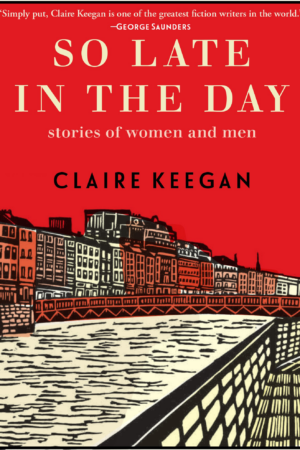So Late in the Day
by Claire Keegan
reviewed by Kevin O'Connor
Those already devoted to the shimmering revelations of Claire Keegan’s fiction may be disappointed that only the title story in her slim new collection, So Late in the Day: Stories of Women and Men, is being published for the first time in book form; the other two stories appeared in her previous collections, Antarctica (1999) and Walk the Blue Fields (2007). But first-time readers, as well as those drawn in by her novellas, Small Things Like These (2020) and Foster (2010)—the basis for the Oscar-winning film The Quiet Girl—will welcome this book as the second debut of a masterful short-story writer.
While Keegan’s most recent book, Small Things Like These, featured a husband and father imbued with humility and growing moral courage, the male characters in So Late in the Day show a limited capacity for generosity and sacrifice. Even as Keegan explores various aspects of misogyny with devastating insight, her stories show a complicated sympathy both for her disappointed women and for her loveless, wounded, and wounding men.
In his book The Lonely Voice, Keegan’s compatriot Frank O’Connor claims that the short story gives voice to marginalized populations. Many of Keegan’s stories concern provincial Irish characters, whether small-town farming folk, lonely priests, or adolescents, struggling with modern problems in a culture haunted by ancient mythologies and a long, tragic history. But the three stories featured here focus on sophisticated, urbane protagonists facing romantic crises. The fact that each story unfolds over a single day—a wedding day, a birthday, a sexual escapade—highlights the lyric economy of Keegan’s prose.
Though there is a strong, self-defined woman at the center of each story, the title story closely follows the feelings and perceptions of Cathal, a young clerk in a Dublin office on his intended wedding day. It is Keegan’s audacious formal choices—setting the story in the aftermath of the breakup and then carefully excavating and dramatizing the sources of his misogynist conditioning—that make this narrative a surprisingly suspenseful tour de force. As his romance plays out through flashbacks, Cathal’s stinginess gradually reveals his greater inability to give more of himself to Sabine, who finally confronts him directly:
“You know what is at the heart of misogyny? When it comes down to it?”
“So I’m a misogynist now?”
“It’s simply about not giving,” she said.
While a rejected Cathal vents his grief in ugly sexist terms, Keegan offers more than just an indictment. She describes a vivid memory of Cathal’s father and brother laughing at his mother during a cruel prank, which suggests that his misogynistic mindset is learned rather than innate. In a characteristically compassionate gesture, Keegan allows for a thin speculative hope that her central character is capable of change even “so late in the day.”
Readers may well imagine that the protagonist of Keegan’s “The Long and Painful Death,” arriving on Achill Island for a writer’s residency on the occasion of her thirty-ninth birthday, is thinking about her own Cathal-like ex-lovers when she remembers “the men she had known and how they had proposed marriage and how she had said yes to all of them but hadn’t married one.” Like Cathal’s Sabine, she puts a former lover to the test: he flunks by admitting he would not give her his land, “and land, as she had always known, was all he cared about.” It is no coincidence that the protagonist is reading Chekhov’s story “The Fiancé,” about a young woman who flees her upcoming wedding to work as an independent scholar. When Keegan’s character is visited by an elderly German academic full of rude, undisguised envy and insulting sexist resentment towards her for her Heinrich Böll Fellowship, she turns, like Chekhov’s feminist precursor, to her work. Keegan’s story writer, like Keegan herself, can sublimate her vengeful instincts by imagining “the long and painful death” of her antagonist:
Already, she had made the incision in place and time, and infused it with a climate, and longing. There was earth and fire and water on these pages; there was a man and a woman and human loneliness, disappointment.
This description so vividly captures Keegan’s own elemental voice, it might have made a fitting end to this volume. Instead, the closing story, “Antarctica,” about a discontented wife on a spree, resists the predictable culmination of a “marriage plot.” “Antarctica” also takes on a characteristically Irish Catholic subject made infamous by James Joyce: the specter of hell as a means of deterrence to “sin,” which in this case is the female protagonist’s deliberate adultery. “Every time the happily married woman went away, she wondered how it would feel to sleep with another man,” writes Keegan. “That weekend she was determined to find out.”
Though realistic on the surface, this story reads like a dark fable about the practical dangers of heedless erotic experimentation. While the tale is premised on the adventurous protagonist’s casual dismissal of traditional religious morality—“If only Sister Emmanuel could see me now, fucking a complete stranger, what a laugh”—it concludes with the bleak irony of an otherwise responsible wife and mother realizing her own personal hell: “There’d be nothing there, only a cold sun, and the devil there watching you.”
Keegan’s stories illuminate the sources of romantic failure while also allowing readers to imagine selves more worthy and capable of love. There is real earth and fire and water in the pages of So Late in the Day.
Published on April 11, 2024

